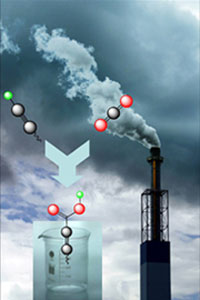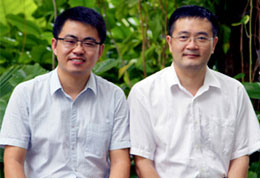| Nov 08, 2010 | |
Scientists develop green technique to transform carbon dioxide into useful compounds |
|
| (Nanowerk News) Scientists at the Institute of Bioengineering and Nanotechnology (IBN), the world's first bioengineering and nanotechnology research institute, have reported another breakthrough in their quest to develop green technologies for pharmaceuticals synthesis. They have devised a new environmentally friendly technique to transform carbon dioxide, an abundant and renewable carbon source, into highly functionalized propiolic acids, which are basic building blocks for the synthesis of a wide range of pharmaceuticals such as cholesterol-reducing drugs and peptidomimetic and other small molecule inhibitors that may be used, for example, to kill cancer cells. | |
| Over the past few decades, there has been much global attention on the chemical fixation and transformation of carbon dioxide into more useful compounds or chemicals. As an environmentally friendly chemical reagent, carbon dioxide is highly sought after in organic synthesis, and significant efforts have been devoted towards exploring technologies for its transformation. However, the harsh and severe reaction conditions required for most current protocols, along with their poor catalytic performance and limited substrate scope, pose major obstacles for their practical application and eventual commercialization. | |
| IBN's approach involves the direct activation of the C–H bond and carboxylation of the terminal alkynes using a novel copper and copper–N-heterocyclic carbene catalyst that the researchers developed specifically for this reaction. | |
 An illustration of the synergistic effect of metal/N-heterocyclic carbene in CO2 utilization. Excellent yields of propiolic acid were obtained from carbon dioxide under ambient reaction conditions without the use of any organometallic reagents. IBN's elegant and economically viable protocol has great potential for real-world applications, as it is also flexible enough to be used with a wide variety of substrates. Moving forward, the IBN researchers hope to further develop this technology for the large-scale synthesis of industrial chemicals from carbon dioxide. "Our research is focused on converting sustainable resources such as carbon dioxide into useful pharmaceuticals through environmentally benign processes," shares IBN Team Leader and Principal Research Scientist Dr Yugen Zhang, who led this research effort. "Ever since the American Chemical Society and Green Chemistry Institute Pharmaceutical Roundtable initiative was launched in 2005 to encourage innovation and integration of green chemistry and green engineering into drug discovery, development and production, more pharmaceutical companies have made the commitment to bring medicines to patients with minimal impact on the environment. We aim to provide them with new and powerful tools that will help them to achieve this goal, while saving their manufacturing costs." According to Professor Jackie Y. Ying, IBN Executive Director, "The vision of our green synthesis platform is to develop inexpensive and safe pharmaceuticals and specialty chemicals. This breakthrough marks a significant advancement in sustainable technologies of interest to the pharmaceuticals and fine chemicals industries. It helps to position IBN and Singapore at the forefront of green chemistry research." |
|
 IBN Pharmaceuticals Synthesis and Green Chemistry Team (from left to right): Dr Dingyi Yu, Postdoctoral Fellow, and Dr Yugen Zhang, Team Leader and Principal Research Scientist. This research is reported in the latest edition of the Proceedings of the National Academy of Sciences [D. Yu and Y. Zhang, "Copper and Copper–NHC Catalyzed C–H Activating Carboxylation of Terminal Alkynes with CO2 at Ambient Conditions," Proceedings of the National Academy of Sciences, (2010) DOI: 10.1073/pnas.1010962107.]. Dr Zhang's team at IBN has also been responsible for several other recent breakthroughs in carbon dioxide transformation (see references below). References 1. S. N. Riduan, Y. Zhang and J. Y. Ying, "Conversion of Carbon Dioxide to Methanol with Silanes over N-Heterocyclic Carbene Catalysts," Angewandte Chemie International Edition, 48 (2009) 3322-3325. |
|
| 2. L. Gu and Y. Zhang, "Unexpected CO2 Splitting Reactions to Form CO with N-Heterocyclic Carbenes as Organocatalysts and Aromatic Aldehydes as Oxygen Acceptors," Journal of the American Chemical Society, 132 (2010) 914-915. | |
| 3. S. N. Riduan and Y. Zhang, "Recent Developments in Carbon Dioxide Utilization Under Mild Conditions," Dalton Transactions, 39 (2010) 3347-3357. | |
| 4. Y. Zhang and J. Y. G. Chan, "Sustainable Chemistry: Imidazolium Salts in Biomass Conversion and CO2 Fixation," Energy Environmental Science, 3 (2010) 408-417. | |
| About the Institute of Bioengineering and Nanotechnology | |
| The Institute of Bioengineering and Nanotechnology (IBN) was established in 2003 and is spearheaded by its Executive Director, Professor Jackie Yi-Ru Ying, who has been on the Massachusetts Institute of Technology's Chemical Engineering faculty since 1992, and was among the youngest to be promoted to Professor in 2001. | |
| In 2008, Professor Ying was recognized as one of "One Hundred Engineers of the Modern Era" by the American Institute of Chemical Engineers for her groundbreaking work on nanostructured systems, nanoporous materials and host matrices for quantum dots and wires. | |
| Under her direction, IBN conducts research at the cutting-edge of bioengineering and nanotechnology. Its programs are geared towards linking multiple disciplines across all fields in engineering, science and medicine to produce research breakthroughs that will improve healthcare and our quality of life. |
| Source: A*STAR |
